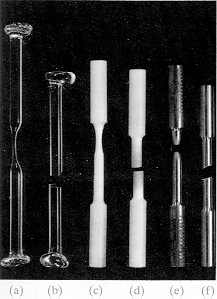|
Fracture
terminates the integrity of a sample which breaks into two or more parts.
The process is material dependent, with some materials being brittle and
others ductile. The photograph shows tensile test samples that have been
tested at different temperatures. Samples (a) and (b) are both glass, but
(a) was tested at 800 K and behaved in a ductile (viscoelastic) way whereas
(b) was tested at 273 K and showed brittle behavior. Poly- propylene samples
(c) and (d) were tested at the same temperature but at different strain
rates. At low strain rates (c) this polymer is ductile but at high strain
rates (d) it shows brittle fracture. The ductile to brittle behavior of
metals is also temperature dependent as shown for a low carbon steel in
(e) and (f). At 273 K (e) the material is ductile at the selected strain
rate but at 200 K the material is brittle. The ductile to brittle transition
temperature increases as the carbon content of this alloy increases.
|
|
 |
|
|
